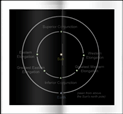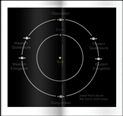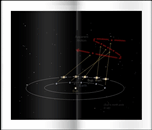
 Theory
Theory 
 Planets Apparent Motion
Planets Apparent Motion
| CONTENT - What are the explanations of how planets appear to move against the background of stars |
| |
Earth is the third planet of the solar system. Mercury and Venus which are between the Sun and the Earth are called inferior planets. Other planets, from Mars onward, are called superior planets. Earth and planets are moving relatively to each other. Planets have an apparent motion relative to background stars as seen from Earth. Inferior planets have their motion taking place not far away from the Sun or related to it. All planets in the solar system are orbiting counterclockwise as seen from above Sun's north pole. For this movement West and East are right and left of the Sun as seen from Sun's north pole independently of the observer's location at Earth. The location of the observer in such or such hemisphere or at the equator does not influence the theoretical description of planets' motion. The main effect is from an observational point of view as in the southern hemisphere planets are seen upside-down and often lying on their edge in the equatorial regions

Relative positions of Earth, inferior planets, and Sun are described by six main positions: inferior conjunction, western elongation, superior conjunction, eastern elongation, and greatest western and eastern elongations. Inferior conjunction occurs when Sun, the planet, and Earth, are in line, inferior planet being between Sun and Earth. As the inferior planet is continuing its orbit counterclockwise it moves to its western elongation. The planet is at a right angle to the Earth relatively to Sun. The planet then moves to its superior conjunction. It is again in line with Sun and Earth,. This time, the planet is on the other side of the Sun however. Continuing on its orbit, the inferior planet is reaching its eastern elongation. It is again at a right angle to Earth relatively to Sun. At last, the planet comes back to its inferior conjunction. Greatest western and eastern elongations occur when the inferior planet, on its orbit, is at its maximum angle, West or East, from the Sun, as seen from Earth
Inferior conjunction, greatest western elongation, superior conjunction and greatest eastern elongation are, for inferior planets, what New Moon, First Quarter, Full Moon, and Last Quarter are for the Moon (at the exception, that a inferior planet cannot be seen Full because it is at its superior conjunction, on the other side of the Sun). Due to how they are lightened by Sun and to their motion relatively to Earth, inferior planets have phases resembling Moon's. At the inferior conjunction, planet is new. It is at this period that inferior planets may display the rare show of their transit before Sun. Then, as the planet is moving West, it evolves into a crescent. It reaches quarter at its greatest western elongation. The inferior planet then becomes waxing gibbous as it keeps moving around Sun. It eventually becomes full at its superior conjunction. Coming back towards Earth, the planet is heading now to its greatest eastern elongation. After having been waning gibbous, it reaches a quarter again. When it comes back to its inferior conjunction, the planet is new again. As far as its angular diameter is concerned the planet, at first, from inferior to superior conjunction, is decreasing in size. When its comes back to its inferior conjunction, it increases in size. Two elongations are period of intermediate size. During their period of western elongation, inferior planets are seen before sunrise, in eastern sky, as "morning star", as, in their period of eastern elongation, they are seen after sunset, in western sky, as an "evening star". Mercury never ventures far away from the horizon, as Venus does -and sometimes very far away. At their conjunctions inferior planets are invisible: they are in Sun's glare
 | A diagram showing how a inferior planet is seen moving against the starry background |
As seen from Earth, superior planets are seen moving on stars background. This apparent motion is partly due to the motion of the planet self on its orbit, and partly to that Earth completing its orbit more quickly than the superior planet. Motion of superior planets features six positions too: opposition, western elongation, conjunction, eastern elongation, and western and eastern quadratures. Assuming a still Earth, the superior planet, at opposition, is in line with Sun and Earth, beyond Earth. The planet continues then its orbit. It reaches its western elongation: it is at a right angle to Earth relatively to Sun. When the planet is again in line with Earth and Sun, beyond Sun, it is at its conjunction. The planet then keeps moving. It reaches its eastern elongation. It is at a right angle to Earth relatively to Sun again. At last, the superior planet comes back to a new opposition. Western and eastern quadratures occur when the superior planet is at a right angle to the Sun, relatively to Earth. Of note that Mars, due to its greatest proximity and its relative motion combined with that of the Earth, is reaching a opposition about each 26 months only as Jupiter each 398 days in average. Jupiter remains one year in each zodiacal constellation. Saturn's opposition occurs each 378 days in average as the ringed planet journeys into a same constellation during 2 years and a half
Conjonction, eastern quadrature, opposition and western quadrature are, for superior planets, what New Moon, First Quarter, Full Moon, and Last Quarter are for the Moon. At its opposition a superior planet is visible all night: it rises as Sun sets; it is nearest to us hence it shines at its maximum. It's too at its greater apparent diameter. At its conjunction planet is invisible: it is lost in Sun's glare. At western quadrature, the superior planet is rising at midnight. At eastern quadrature, the planet is South (or North in the southern hemisphere) when Sun sets. Superior planets have phases too but they are limited to waxing/waning gibbous/full: waning gibbous from opposition to western quadrature, waxing gibbous then, to conjunction and eventually full at conjunction. Waning gibbous from conjunction to eastern quadrature, then waxing gibbous down to opposition and full at opposition. Such phases are mostly noticeable, on an observational point of view, at Mars, as they are not for Jupiter nor Saturn. As far as Uranus, Neptune, and Pluto are concerned, those planets are that far, that their phases are not observable and that, further, they are presented, theoretically, like having none
The western and eastern quadratures of a superior planet are interestingly the moments when, as seen from Earth, a superior planet reverses its motion relatively to stars background. Assuming, this time, a moving Earth and a -relatively- still planet, the latter, as seen from Earth, appears, most of time, to move from West to East in the northern hemisphere and from East to West in the southern hemisphere. This motion is called the planet's "direct motion". This is due to the motion of the planet on its orbit as that motion occurs counterclockwise around the Sun. When the Earth is reaching the point where the superior planet is seen at its western quadrature, it overtakes the planet: Earth is orbiting Sun more quickly than the superior planet. The superior planet then appears to reverse its motion. For a while, it will appear moving from East to West (or West-East). This reverse motion is called "retrograde motion". When Earth reaches the point where the superior planet is seen at its eastern quadrature, the superior planet comes back to its usual direct motion
That specific period of the relative motions of both the Earth and a superior planet thus yields, each year, that fine looping motion that the superior planet seems to follow against the background of the starry sky! The opposition of the superior planet occurs about mid-way of the retrograde leg of the loop. As far as our sketch is concerned, we could not render that loop accurately howeverfor reason of how we drawed the sketch. That distinctive feature of the superior planets' motion had brought ancient astronomers to a very complex mechanics. The Ptolemaic system with planets and the Sun circling the Earth, had been augmented with 'epicycles' which were small motions of planets around their main orbit. Copernicus eventually simplified that question as he placed the Sun at the planetary system's center as it was eventually Kepler who provided for the definitive explanation through his mathematical analysis
 | A diagram showing how a superior planet is seen moving against the starry background |
Website Manager: G. Guichard, site 'Amateur Astronomy,' http://stars5.6te.net. Page Editor: G. Guichard. last edited: 3/2/2016. contact us at ggwebsites@outlook.com






